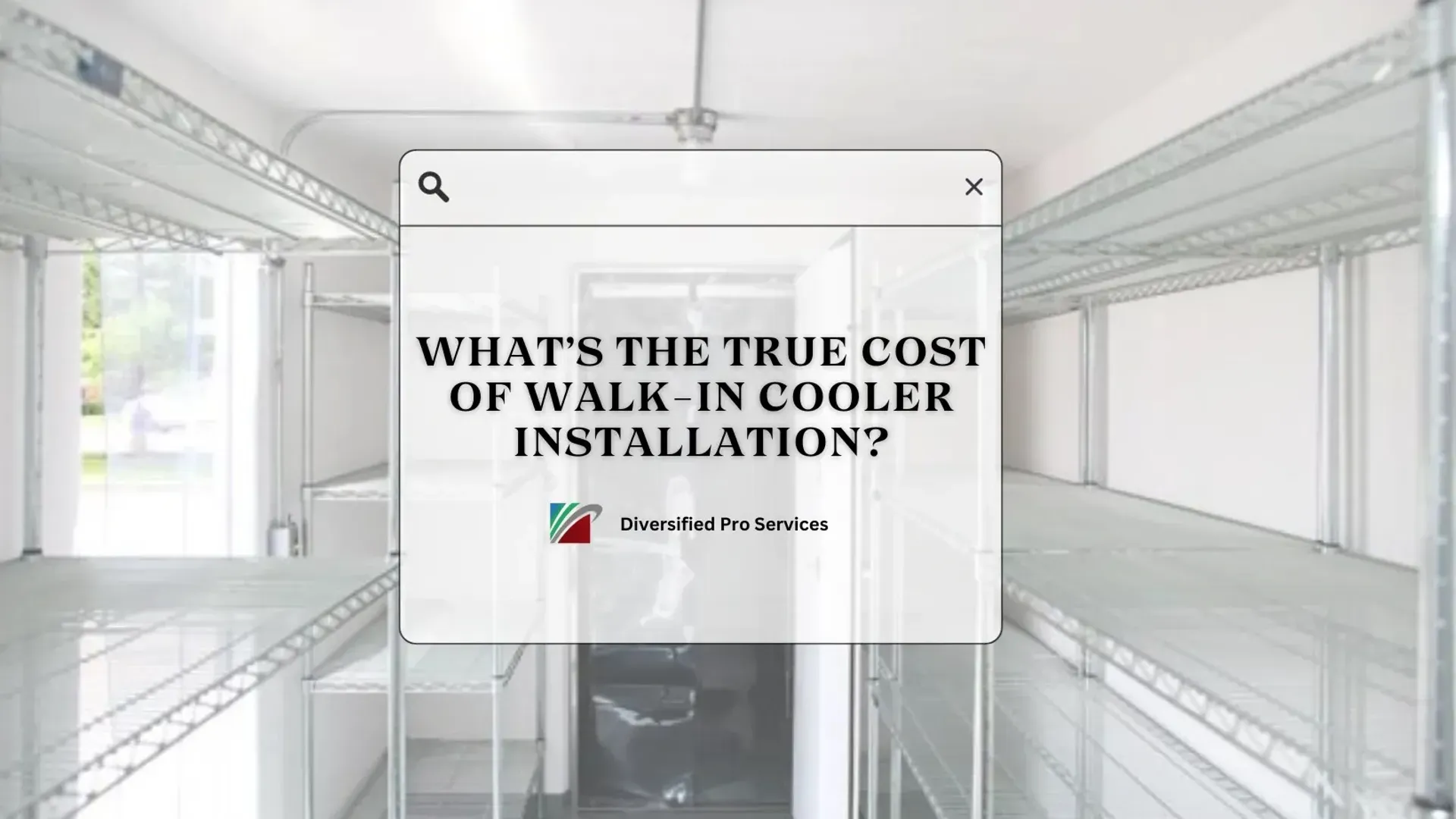Cool Conveniences: What’s the True Cost of Walk-In Cooler Installation?
AS FEATURED IN

Exploring the Appeal of Walk-In Coolers
The appeal of walk-in coolers lies in their ability to provide efficient and convenient storage for perishable goods. Unlike traditional refrigerators, walk-in coolers offer a larger storage capacity, making them ideal for commercial purposes such as restaurants, grocery stores, gas stations and food distribution centers. Additionally, the accessibility and ease of organization within a walk-in cooler contribute to its appeal, allowing for quick retrieval of items without the constraints of limited space. One major factor that contributes to the appeal of walk-in coolers is the cost-efficiency associated with installation and maintenance. Although the upfront costs may be higher than traditional refrigeration units, the long-term savings are evident.
For example, automatic sliding doors on walk-in coolers help maintain temperature control more effectively than regular swinging doors; this can result in energy savings over time due to reduced cold air loss. Moreover, the versatility and customizability of walk-in coolers allow businesses to optimize their storage space efficiently according to their unique needs.
Furthermore, with advancements in technology and design innovations, modern walk-in coolers come equipped with features that enhance functionality while keeping operating costs low. For instance—hey readers—smart temperature monitoring systems can automatically adjust cooling levels based on inventory load or external weather conditions. This not only reduces wasted energy but also ensures consistent freshness for stored products. Collectively, these factors contribute to making walk-in coolers an appealing choice for businesses seeking effective cold storage solutions. Factors to Consider: size, location, cost breakdown, equipment, installation, maintenance, energy efficiency, long-term savings vs initial investment, regulatory compliance, building codes and permits, with additional considerations including warranty, service, and repairs. Conclusion: weighing the pros and cons is purposeful to clarity and having the right professionals available to provide these answers and do the work, bringing an excellent investment to the business…
Benefits of Walk-In Coolers for Businesses
Walk-in coolers offer numerous benefits for businesses in the food and beverage industry. One significant advantage is the cost efficiency of walk-in coolers compared to sliding door refrigerators. While the initial investment may be higher, walk-in coolers are more energy-efficient and offer larger storage capacity, resulting in long-term cost savings. Businesses can also customize the size and layout of their walk-in coolers to fit their specific needs, maximizing organizational efficiency. Furthermore, walk-in coolers provide better temperature control than sliding door refrigerators, ensuring that perishable goods are kept at optimal conditions. This contributes to a longer shelf life for products and reduces waste, ultimately benefiting the bottom line of businesses. Additionally, walk-in coolers offer more accessibility and space for employees to navigate and organize inventory efficiently, improving workflow within the business operation. In conclusion, while the cost of installing walk-in coolers may seem daunting initially, businesses will reap long-term benefits in terms of cost savings, improved product quality, and enhanced operational efficiency. Investing in a well-designed walk-in cooler can contribute significantly to the success and profitability of businesses in the food and beverage industry.
Factors Affecting the Cost of Installation
Factors affecting the cost of installation for sliding doors can be influenced by several key elements. The size and material of the sliding door play a significant role in determining the overall cost of installation. Larger doors or those made from premium materials will naturally come with a higher price tag due to increased manufacturing and installation expenses. Additionally, the complexity of the installation process can impact costs, as intricate designs or unconventional placements may require additional labor and expertise. Finally, factors such as location and accessibility of the installation site can also affect pricing, as difficult-to-reach areas or remote locations may result in higher labor costs. Another crucial factor influencing installation costs is the quality of hardware used in the sliding door system. High-quality tracks, handles, and locking mechanisms not only ensure durability but also contribute to a smoother operation over time. Investing in superior hardware may increase upfront costs but can lead to long-term savings by reducing maintenance and replacement expenses. Furthermore, customization options such as decorative glass panels or energy-efficient features could raise installation costs due to specialized manufacturing requirements and additional assembly time. In conclusion, understanding these influential factors allows location owners to make informed decisions regarding their sliding door installations while considering budget constraints and desired outcomes. By weighing factors like size, material quality, complexity of design and customization options against individual priorities and financial considerations, it becomes possible to manage expectations while achieving an optimal balance between cost-effectiveness and aesthetic appeal.
Energy Efficiency: Long-Term Savings vs Initial Investment
When considering energy efficiency, many businesses weigh the initial investment against the long-term savings. One area where this debate often arises is with sliding doors. While the upfront cost of installing an energy-efficient sliding door may be higher than a standard model, the long-term savings in energy bills can be significant. As these doors are designed to minimize heat transfer and maintain internal temperatures, they contribute to reduced heating and cooling costs over time. Moreover, the environmental impact of energy-efficient sliding doors cannot be overlooked. By reducing energy consumption, these doors help lower carbon emissions and contribute to a more sustainable future. It's important for location owners to consider not only the immediate financial implications but also the broader social and environmental benefits when making decisions about investments in energy efficiency. Ultimately, while there may be a higher initial cost associated with energy-efficient sliding doors, the long-term savings and positive impacts make them a wise choice for environmentally conscious business owners.
Hidden Costs to Consider
When considering adding a sliding door to your commercial cooler, it's essential to factor in more than just the upfront cost of purchasing and installing the door itself. One often overlooked expense is maintenance and repairs. While sliding doors are designed for frequent use, they can still wear down over time due to constant opening and closing. Components like tracks, rollers, handles, and glass panels may require periodic upkeep or replacement, adding an ongoing cost that should not be underestimated. The rule is, the better the materials and equipment, and team that handles the installation, the more certain a business can be that there will be fewer of these instances across time. Furthermore, there's also the risk of breakage or damage from accidents or wear-and-tear that could result in unexpected repair expenses down the line.
Choosing the right Walk-In Cooler for your needs
When it comes to selecting the right walk-in cooler for your specific needs, considering the cost of sliding doors should be a top priority. While swing doors offer convenience, sliding doors can provide significant cost savings in terms of energy efficiency and maintenance. Despite potentially higher upfront costs, the long-term benefits of reduced energy consumption and easier maintenance make sliding doors a compelling choice for those looking to maximize their investment. Furthermore, it's essential to assess your space requirements carefully before making a decision. The layout and size of your establishment will play a crucial role in determining the most suitable walk-in cooler for your needs. By carefully evaluating your available space and considering factors such as traffic flow and storage capacity, you can ensure that the chosen walk-in cooler fits seamlessly into your operational environment while meeting all your refrigeration needs.
Making an Informed Decision for your Business
In conclusion, when making a decision for your business, it is crucial to consider the full spectrum of factors involved rather than solely focusing on the visible costs. A potential cost-saving in one area may lead to higher expenses or missed opportunities in another. Therefore, it is essential to weigh the long-term benefits and drawbacks of different options before finalizing a decision. Moreover, taking into account the various aspects such as durability, energy efficiency, and maintenance costs can provide a more comprehensive understanding of the total cost of ownership for sliding doors. Understanding these nuances will enable you to make an informed decision that aligns with your business goals and budget constraints while ensuring long-term satisfaction with your choice.
 " class="object-cover object-center">
" class="object-cover object-center">  " class="object-cover object-center">
" class="object-cover object-center">